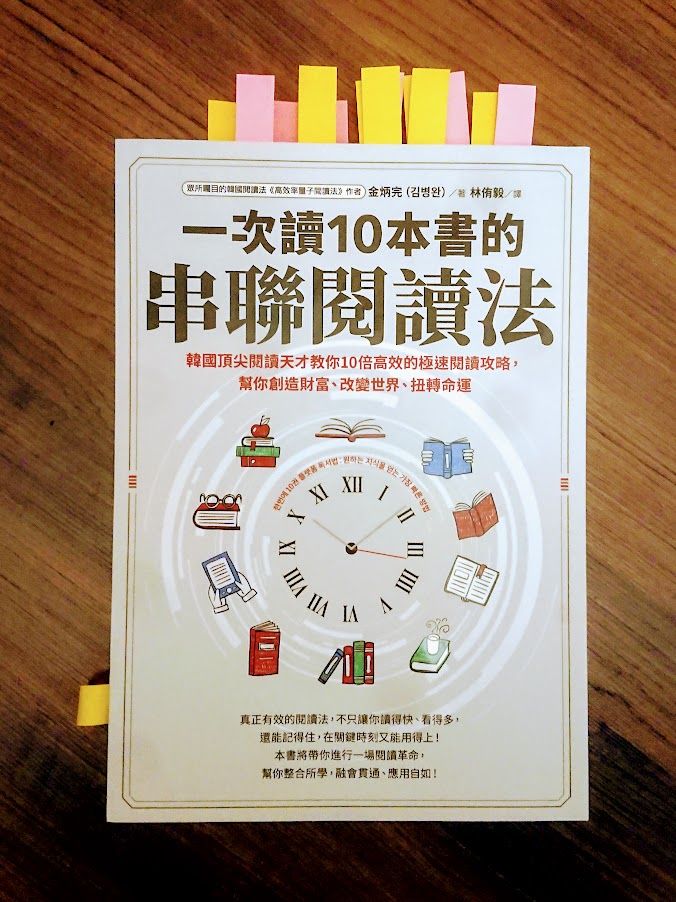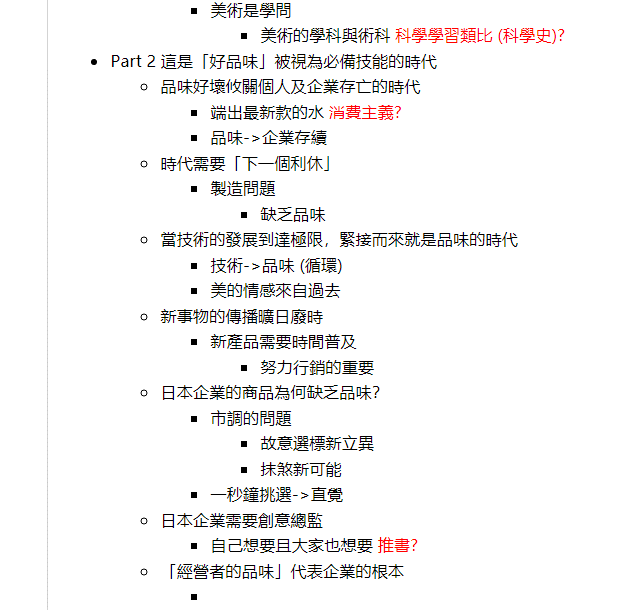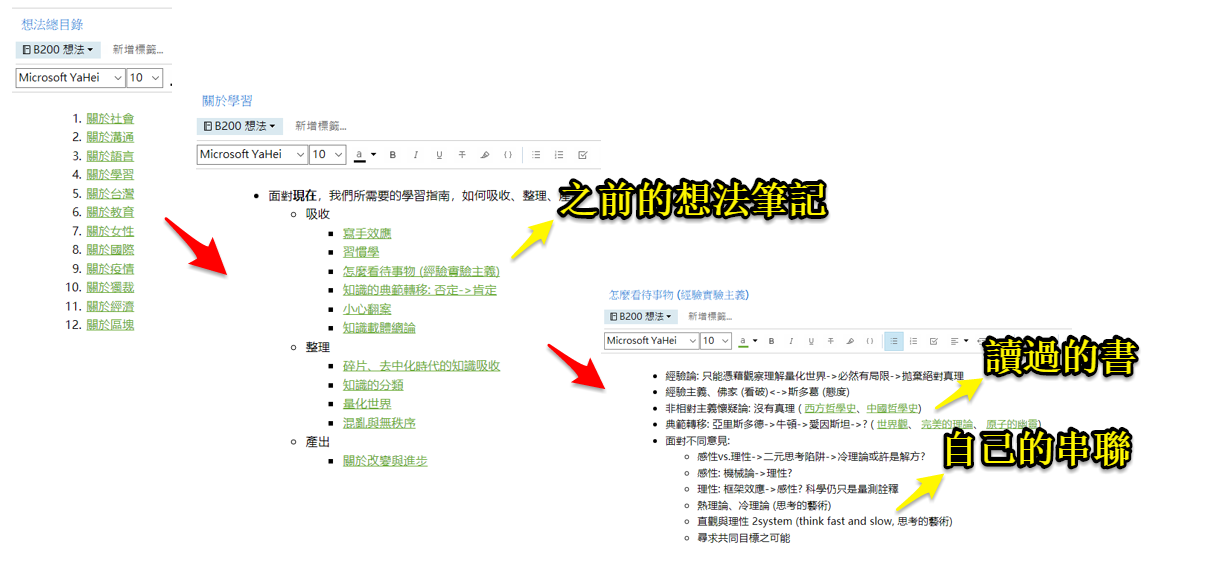
半導體外商的小小螺絲釘,遊走於廢青與社畜之間。熱愛閱讀,喜歡透過書本探索外在、內化自我。希望藉由書寫打開與世界交流的一扇窗。 個人部落格:https://maxjamesread.com/
"Concatenated Reading Method of Reading 10 Books at a Time": Give yourself a big reading platform!

Do you find it difficult to read? Read slowly? It's hard to read it, but it doesn't seem to absorb much? Did nothing change? Today's introduction to the "Concatenated Reading Method of Reading 10 Books at a Time" may bring you some inspiration.
The life experience of the author Kim Byung Wan is very strange. Formerly a Samsung researcher, he resigned resolutely because he realized that life at work is like falling leaves (this...), and started a reading challenge in the library, spending three years reading 10,000 books. And this book is to promote the "tandem reading method" that helps him read books at high speed.
In this article, I will first explain what the tandem reading method is and what are the advantages compared with the traditional reading method; then I will talk about this reading method from my point of view, and what blind spots may be in the operation; finally, I will share with you about my How to use tandem reading.
[What is the tandem reading method]
The tandem reading method is also known as the "platform reading method". This is the author's inspiration from the giants of the Internet age. He believes that companies such as Google, Facebook or Amazon can become giants because they create a "platform". For example, Facebook itself does not produce content, but it has a great impact by uploading posts and interacting with each other by a large number of users.
The author extends this notion to reading. It is mentioned in the book that the possession and expansion of knowledge is not the most important thing. If we can build a platform for connecting knowledge, and then thinking and evolving, the effect will be even greater.
The primary goal of the tandem reading method is not to read a lot of books or to have a wealth of knowledge, but to connect the content and knowledge of each book and build a platform through interaction.
So how to create such a reading platform? The author proposes the following 7 steps:
- Decide on a target topic to read
- Pick multiple books at once that are highly relevant to the topic
- Read multiple books quickly at the same time
- Select from the book the content related to the topic and copy it in your own words
- Extracting and transcribing ideas and classifying and concatenating them to create new knowledge
- String new knowledge into a topic-specific platform database
- Verify that the platform can solve the theme set at the beginning
Compared with the traditional reading method, the tandem reading method has the following four advantages:
[I. Problem Orientation]
Compared with the traditional way of reading without missing a word, but aimlessly, the tandem method is problem-oriented reading. Because you set the topic you want to discuss or solve first, you won't finish reading it and don't know how to apply it.
[2. Accelerated reading]
The concatenation method can speed up the reading speed. As the author said, reading speed is actually equal to thinking speed. Many traditional speed reading methods put too much emphasis on the speed of eye movement, while ignoring that the "brain" is the key to reading. It's no use reading fast but not understanding.
The concatenation method has a clear goal, so it is necessary to use the brain to think when reading, not to inhale the words without a brain. As a result, it can be read faster.
The essence of reading is not decoding words, but thinking of the brain.
(Three, serial knowledge)
Compared with most people's habit of reading one book and then the next, the concatenation rule forms a "reticulated reading" structure by reading multiple books at a time.
That is to say, the knowledge points originally scattered in different books can form a more complete and comprehensive knowledge network through the concatenation method. Fragmented knowledge can be linked by readers to create an integrated structure.
[IV. Innovation Possibility]
In addition to integrating knowledge, the biggest advantage of the tandem method is that it can stimulate new possibilities through such an integrated network.
Compared with the traditional reading method, which can only acquire knowledge in one direction, the tandem reading method can link information in two directions, build a platform that can accommodate various knowledge, and then interact through these data links to "regenerate" new ideas and insights.
Innovation is to connect various elements together. Only by connecting different things, especially things with high heterogeneity, can creativity appear. - Jobs

【Blind spots of tandem reading method? 】
Looks pretty good right? However, I think this method, although it looks great at first glance, may have some small problems in practice. Let's move on to this part.
[Understand the problem? ]
First of all, I am a bit skeptical about the comprehension effect of the concatenation method. Although the author emphasizes that there is no need to worry too much about understanding when connecting, as long as you connect the knowledge in each book freely like playing a game, you can discover new ideas. But if there is even a problem with understanding the basic content, can it really generate insight?
If it's a more familiar topic, it may be possible to connect several books directly. But if you are in an unfamiliar field that is far away from you, and you can directly find a bunch of books to read, it will be very difficult to think about it. For example, you want to learn financial management, but you have no concept of investment, so you find books on indexed investment, value investment, and technical analysis, and read them all together. How do you think it is a disaster?
[Read more and faster? ]
The author claims to have read 10,000 books in three years in this way. But is it really possible to read that fast?
It was mentioned earlier that reading speed depends on thinking speed. In fact, the part of my reading that I spend the most time with is when I stop and think and try to integrate, connect, and think. If you want to follow the way in the book, concatenate the knowledge of each book and then think about it, the reading speed may be difficult to mention.
Honestly, I don't think reading a few books a year really matters too much. The point is whether the content has an impact on yourself. If you read reference books, you should think about whether what you have learned has really been applied; if you read literature books, you should pay attention to whether the content resonates.
However, the author actually emphasized many times in the book that the focus is on concatenation, rather than how many books to read. Perhaps for advertising, we have to emphasize high-speed reading to increase attractiveness.
[Accidental knowledge link was erased? ]
Lastly, and most importantly to me, the topic-setting reading method, while focused, can sometimes be self-defeating because many intellectual connections are often not in the expected quadrants.
When I recently reread the fragility transition paragraph in " Antifragile ", it immediately reminded me of the Luna incident a few days ago. Many project parties in the currency circle just let themselves enjoy the benefits of the upper class and let the leeks bear the losses of the lower class. If I were only looking for books on the topic of blockchain, I might have missed the opportunity to connect like this.

[How do I use concatenation]
Wouldn't the tandem reading method work? In fact, I really like the idea of creating a platform to connect knowledge. So in this paragraph, I want to share how I use the concatenation method.
[Lab reading method]
This method was taught to me by the supervisor of the master class, and it is tentatively called the laboratory method (laughs). What the research is doing is semiconductor packaging . The teacher gave this advice to me, who was just Sheng Shuoyi at that time:
First read the classic books and review papers in the field of packaging to establish a roughly complete concept. Then read a lot of paper to see what everyone is working on. Then think about what research directions you can take.
So I read " Solder Joint Technology " written by my teacher Du Jingning and the review paper published by my professor. Then go to the database to find a large number of Paper comparison references for the sub-themes (such as electromigration).
The last part of reading a lot of Paper is actually the concatenation method mentioned in this book. Therefore, the difference from the concatenation method is that only in the research lab, the "classics" are read first, and the basic concepts of a field are established, and then a large number of concatenations are carried out.
And this method can also be applied to the general reading field. For example, if you want to strengthen investment, you can first read classics like " Walking on Wall Street " to understand technology, value, and index investing, and then you can find related books for small topics (such as value investing) to read in series. This solves the comprehension problem mentioned earlier.
The book mentions that many reading masters, such as Jobs and Bill Gass, like to read encyclopedias for this reason. Using encyclopedia to build a basic steel frame for a field, and then ingesting relevant knowledge will be more handy.
[Wandering reading method]
But to be honest, aside from the high-purpose status of the graduate school (wanting to graduate...), I usually read them one by one. And I don’t usually read books on the same topic all the time. It’s like a random walk. It’s better to call it a wandering reading method (it is hard to choose). In addition, I will take notes when reading the book. In addition to objectively recounting the content of the book, I will also record subjective thoughts and knowledge in red letters.

Such wandering reading is not limited to a single field, and allows concatenation to occur naturally, addressing the problem of missing connections. For example, when I was writing the above paragraph on the research method, I suddenly thought that this method is very similar to the three steps of knowledge accumulation in " Taste Begins with Knowledge", and accidentally found a very interesting connection.
[Note series method]
And the platform concept of this book also gave me a new idea of connecting. I've created many idea notes in Evernote in the past, but it's fragmented and lacks a system. So I organized these notes into 10 or so "themes" according to the concatenation method.

I write down the goals I want to discuss in these field notes, and use Evernote's note link function to organize the originally scattered ideas into a layered structure like the one below. Then integrate your thoughts with past notes, books, and articles you read.

So I built what I call a platform in the book. After that, no matter what related concepts you read from online articles or books, you can flexibly expand into them. However, I have just started playing, and I am still very immature. I will share more progress with you in the future.
A few days ago, I saw a video of Super Crook sharing the cultural shock of studying abroad, which was very interesting. He said that Asian students may read 10 or 20 books, but they will not be able to extract any very strong questions; but European and American students may have read 40 pages and can ask a very interesting question. This is also the part that I think I need to strengthen. I hope that through this connection, I can open up ideas.
https://www.youtube.com/watch?v=1UYhXkNC59I
【Summarize】
To sum up, the tandem reading method is to use purposeful reading to learn from many books on the same topic at a time, and to build a platform for knowledge interaction to achieve the effect of integration and even creation of new knowledge.
The idea of concatenating the network is good, but I don't think it's so easy to implement in practice. Therefore, I propose some methods of my own, which are considered savage exposure, and everyone can refer to it. As the author says:
It does not mean that you understand the tandem reading method, and you will only read in this way in the future, but you must create your own unique reading method based on this.
The book also shares various reading methods such as transcription reading method, editing engineering reading method, and topic reading method. Although the author's conclusion is that the concatenation method is the best, I think these methods are actually very good, and everyone can refer to them to play.
In short, reading must return to the self after all, and there is no need to force any reading method to be applied to it. Give yourself some time, slowly try and make mistakes, grow, and I believe that you will definitely find your own way of reading.
[Postscript: Miscellaneous thoughts on the platform]
I am very impressed with the concept that the author mentioned that "a platform refers to allowing users to enter the same space and create the best solutions for new value problems".
In " Blog 100 Special ", I talk about the reason why the blog is called the reading "space" of Mrs:
I hope you can walk in here at ease, wander freely, find a comfortable place to contemplate alone, or discuss with me, or communicate with others.
I have been looking forward to promoting reading, so that more knowledge can be seen, and then interacting with readers, exchanging ideas, and then innovating ideas and finding more possibilities. When I read this book, I suddenly realized that the space I want to create is the so-called "platform".
At present, neither blogs, fans or IG seem to have achieved such a desire. It can only be said that in addition to continuing to adjust existing resources, there is a chance to try and look at different media. I hope that one day I can realize my expectations for "space".
In short, thank you very much for seeing you here, and I hope you have a good time in this space. I also look forward to your message to communicate with me and increase the multi-connection of the platform.
Finally, I wish you all to find the most suitable reading path for you, and give yourself a big platform!
Articles you may also be interested in:
- How to Read a Book: What? Do you need to be taught to read? Four-level reading will lead you to truly understand a book!
- "Technology of Deep Learning": Take you to build a 5-level powerful learning system!
- "Learn English Speed Reading in 6 Lessons": Professor of National Taiwan University teaches you the "High Comprehension Speed Reading Method"!
- "Minimalist Reading": Facing the era of knowledge anxiety, you must know "RIA demolition calligraphy"!
- "Efficient Reading Method in the Slash Era": Self-learning and self-learning of the four essential modules in modern times!

↓↓You are also welcome to follow the Facebook and mourning of "Mrs's Reading Space"↓↓
James' reading space FB
James' reading space IG
Like my work?
Don't forget to support or like, so I know you are with me..
Comment…